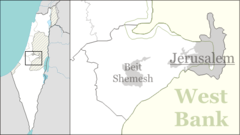1989 Tel Aviv–Jerusalem bus attack
| Tel Aviv–Jerusalem bus 405 suicide attack | |
|---|---|
| Part of the Israeli–Palestinian conflict | |
 Memorial site for the victims | |
Location of the attack | |
| Native name | הפיגוע בקו 405 |
| Location | Near Kiryat Yearim, Israel |
| Coordinates | 31°48′03″N 35°05′40″E / 31.80083°N 35.09444°E |
| Date | 6 July 1989 (UTC+2) |
| Deaths | 16 civilians |
| Injured | 27 civilians |
| Perpetrator | Abd al-Hadi Rafa Ghanim |
| Assailant | Abd al-Hadi Rafa Ghanim |
| Participant | 1 |
The Tel Aviv–Jerusalem bus 405 attack (Hebrew: הפיגוע בקו 405) was an attack that occurred on 6 July 1989, during the First Intifada, and was carried out by Abd al-Hadi Ghanim, a 25-year-old militant of the Palestinian Islamic Jihad.[1] On a crowded Egged commuter bus line No. 405 en route from Tel-Aviv to Jerusalem, Ghanim seized the steering wheel of the bus, running it off a steep cliff into a ravine in the area of Qiryat Ye'arim.[1] Sixteen civilians—including two Canadians and one American—died in the attack, and 27 were wounded.[2]
The incident has been described as the first Palestinian suicide attack, despite the survival of the attacker.[3][4][5][1] It had also been described as a "commandeered crash" and an act with "definitional ambiguities", owing to the it appearing to have been motivated by personal revenge.[6] Despite this, the act was quickly labelled as terrorism by both sides in the Israeli–Palestinian conflict for reasons relating to the political discourse at the time.[6]
Attack
On 6 July 1989, Egged commuter bus line No. 405 began its regular Highway 1 route from Tel Aviv to Jerusalem. When the bus passed Neve Ilan, one of the passengers, Abd al-Hadi Rafa Ghanim, attacked the driver, seized the steering wheel and pulled the bus over a steep precipice into a ravine in the area of Qiryat Ye'arim. The driver was unable to stabilize the bus; as a result the vehicle rolled down the depth of the ravine and caught fire. Some of the passengers were burned alive.[1]
Sixteen civilians were killed in the attack, including two Canadians and one American, and 27 were wounded. Students from the Telz-Stone yeshiva who heard the screaming rushed to the scene to administer first aid. One of them, Yehuda Meshi Zahav, went on to found ZAKA, a volunteer rescue service organization.[1]
Assailant
The assailant, who survived the crash, received medical treatment for his injuries in an Israeli hospital. After the attack, it was revealed that the assailant was a 25-year-old Palestinian Islamic Jihad militant named Abd al-Hadi Rafa Ghanim who originated from the Nusseirat refugee camp in the Gaza Strip. Ghanim was convicted and given 16 life sentences for murder, hijacking and terrorism. On 18 October 2011, Ghanim was transferred from a prison in Israel to the Gaza Strip as part of the Gilad Shalit prisoner exchange between Israel and Hamas.[7][8]
In popular culture
- Israeli singer Ruhama Raz recorded the song "As Rachel Waited" (כחכות רחל), which she wrote in memory of her sister, Miriam Tzerafi, who was killed in the attack.[9]
See also
References
- ^ a b c d e "This Week In History: Terror attack on Bus 405". Jerusalem Post. July 2012.
- ^ גדות, יפעת (6 July 2009). פיגוע אוטובוס 405 [1989] (in Hebrew). News1. Retrieved 6 July 2009.
- ^ Dzikansky, Mordecai; Kleiman, Gil; Slater, Robert (10 October 2011). Terrorist Suicide Bombings: Attack Interdiction, Mitigation, and Response. CRC Press. ISBN 978-1-4398-7131-7.
- ^ Asal, Victor; Phillips, Brian J.; Rethemeyer, R. Karl (2022). Insurgent Terrorism: Intergroup Relationships and the Killing of Civilians. Oxford University Press. ISBN 978-0-19-760701-5.
- ^ Aran, Gideon (2023). The Cult of Dismembered Limbs: Jewish Rites of Death at the Scene of Palestinian Suicide Terrorism. Oxford University Press. ISBN 978-0-19-768914-1.
- ^ a b LeVine, V. T. (1995). "The logomachy of terrorism: On the political uses and abuses of definition". Terrorism and Political Violence. 7 (4): 45–59. doi:10.1080/09546559508427317.
- ^ Levy, Elior (13 October 2011). "Names of prisoners in Shalit deal trickle through Arab media". Ynet. Retrieved 4 July 2018.
- ^ "As it happened: Mid-East prisoner exchange". BBC News. 18 October 2011. Retrieved 4 July 2018.[dead link]
- ^ "Miriam Tzerafi" (in Hebrew). Archived from the original on 3 April 2012. Retrieved 8 September 2011.
External links
- Bus incidents in Israel
- Islamic Jihad Movement in Palestine attacks
- Terrorist incidents in Asia in 1989
- 1989 road incidents
- Attacks on buses by Palestinian militant groups
- Mass murder in 1989
- Islamic terrorist incidents in the 1980s
- 1989 murders in Israel
- Terrorist incidents in Israel in the 1980s
- Terrorist incidents in Jerusalem in the 1980s
- 1980s in Tel Aviv
- July 1989 events in Asia
- 20th-century mass murder in Israel
- 20th-century mass murder in Jerusalem
- First Intifada
- Suicide attacks

